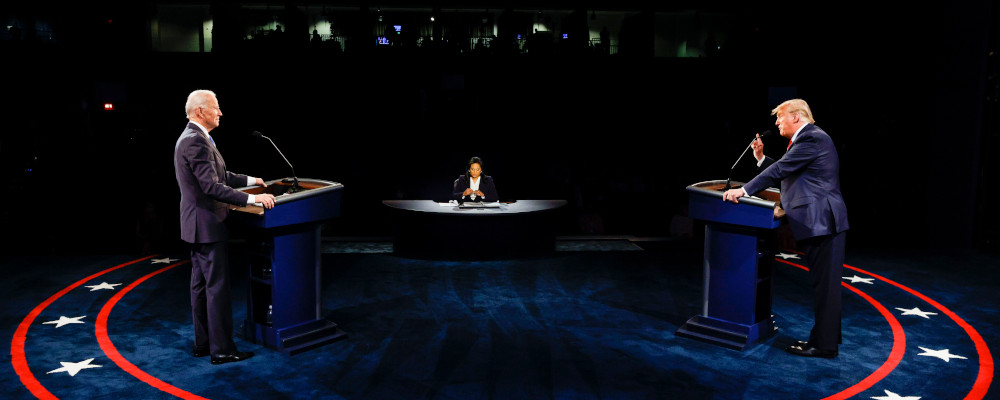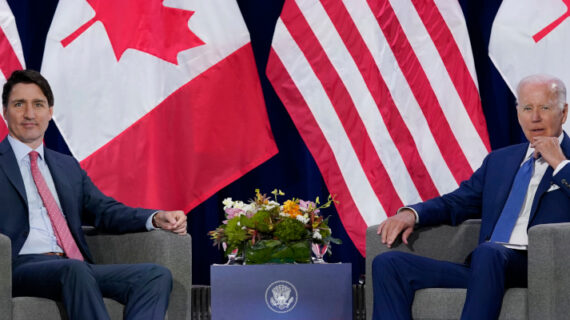It doesn’t take a genius to see the United States is in peril as it hurtles towards an election that plainly cannot resolve the many suspicions and furies besetting the country. Allegations of fraud seem inevitable. Donald Trump essentially said as much recently in New Hampshire.
Should Trump lose he’ll face criminal trials. Surely, surely his dark star will finally fade. If he wins…well, let’s just say things will get complicated, including legally.
But regardless of his particular fate, the current social fracture in America will likely live on, simply because the national institutions that underpin civil life in America are so weakened that they can’t play the role of referee, can’t command national respect, can’t tamp down dissent.
Institutions are important. They are the “they” we mean when we say: “They better do something about that.” The authorities. The system.
Americans enter this most impactful, and ominous, year not only terribly divided but also deprived of any national institution—except, maybe, one—which retains credibility and offers stability.
Could Canada be next? Is our internal cohesion as weak? Can we be made to distrust our national institutions too? Watching American politics seems like a car accident in slow motion, pretty hard to stomach. Are we next?
Here’s my list of familiar institutions that used to be respected as pillars of civil society and now…aren’t.

U.S. Congress
The U.S. Congress is a curious institution. It was carefully designed by the Founding Fathers to force the various “factions” to act nationally. The whole premise is to require compromise to get things done.
And for two centuries that’s mostly what it did. (And when it didn’t they had a Civil War.)
Wheeling and dealing to get things done was—for decades—the lore of Congress.
President Lyndon Johnson cut deals with Republicans to pass the 1964 Civil Rights Act. As he negotiated, LBJ told Vice President Hubert Humphrey to spend time with his arch-rival Minority Leader Republican Everett Dirksen: “You’ve got to let him have a piece of the action. He’s got to look good all the time.”
Ideological enemies such as Ronald Reagan and Tip O’Neil cooperated in the 1980s to, among other things, cut taxes, name a woman to the Supreme Court, and approve the Intermediate-Range Nuclear Treaty.
The basic Madisonian model worked. But in the last two decades, politicians found it better to not get things done rather than to compromise. Republican Speaker John Boehner (who these days looks like a relative moderate) gave expression to this reality in 2010 when asked about President Obama’s agenda: “We’re going to do everything—and I mean everything we can do—to kill it, stop it, slow it down, whatever we can.”
As Jennifer Wolak notes in her book Compromise in an Age of Party Polarization, the politicians are just doing what they are told: “…compromises seem increasingly uncommon in Congress…people value partisan fidelity and ideological congruence from their representatives above all else.”
Voters may consistently tell pollsters they want compromise. But at least those who select today’s Congress overwhelmingly reward politicians who “fight” more than those who deal.
Hopelessly divided, Congress has lost any image it once had as an institution capable of overcoming partisanship to serve the whole country.
The judiciary
It’s hard to exaggerate the role of the courts in American culture.
How many movies included a climatic court scene in which the truth is finally revealed? How many TV shows end in an explosive revelation in court? A strict judge sat high above the fray, tolerating no nonsense. He—it’s always a he—represented the embodiment of the establishment. The courtroom is where the games ended and the consequences began.
But today the judiciary is seen as simply another forum for the political war. Media coverage of any consequential legal decision will now include a note as to which president appointed the judge, continuously suggesting that judges aren’t motivated by their oath of office but by loyalty to a political party or a set of politically-adjacent dogmas.
In 2023 less than half of Americans polled told Gallup they have “a great deal” or “a fair amount” of trust in the Supreme Court. In the past trust in the judicial branch averaged 68 percent.
Law enforcement
No institution was more rapidly and surprisingly demoted in public regard than the FBI.
Shortly before President Donald Trump took office, the Pew Research Center reported that 76 percent of Republicans had a positive view of the FBI. Two years later positive impressions among Republicans fell to 49 percent. By 2023 it was 38 percent.
Combined with revelations of gifts to Supreme Court judges, the video of George Floyd dying under a policeman’s knee, and a seemingly endless list of police shootings of African Americans, it’s not been a great time for the image of law enforcement. A critical element in social stability is fading.
As he was releasing security videos of the January 6 riot, current House Speaker Mike Johnson announced that he had ordered staff to blur the faces “because we don’t want them to be retaliated against and to be charged by the DOJ.” An American public perhaps numbed by the endless list of things-that-could-never-happen-that-are-actually-happening seemed barely to notice this incredible comment; the top lawmaker in the nation saying he’s trying to help criminals avoid the Justice Department.
Supreme Court judge Louis Brandeis famously wrote: “Crime is contagious. If the government becomes the law breaker it breeds contempt for laws.”
But maybe that’s the point: laws are, after all, a constraint on the most ambitious and unscrupulous. Laws, enforced, are a form of accountability and not everyone wants to be held accountable.

News media
For most of U.S. history, the media made no pretense of fair and balanced coverage. But there was a period when the major news networks covered news nationally and internationally, aspiring to fairness and neutrality. The major television networks exercised oligopoly powers, the news audiences were enormous. Most Americans saw pretty much the same news every night.
A host of “national” news anchors—Walter Cronkite, John Chancellor, David Brinkley, Peter Jennings—enjoyed credibility through their careful neutrality and the sense that their motives were simply to inform. When Cronkite returned from Vietnam in 1968 to conclude—on air—that the war was a stalemate that the U.S. couldn’t win, President Johnson is supposed to have said “If I’ve lost Cronkite, I’ve lost the country.” (He probably said nothing of the sort, but he might as well have since it was true.)
In the last decade, the advent of new technology broke the oligopoly and allowed hundreds of “new” news sources. The democratization of the industry has arguably had some good and bad effects. But it’s impossible to deny that the ease and reach of these offerings—and the enormous profitability of more tribal and provocative approaches—has destroyed the business model for neutral broadcast news.
It hasn’t taken long for audiences to segregate themselves. A majority of viewers now select coverage that conforms to their views. Large parts of the U.S. population are getting reinforcement rather than information. When a story appears that challenges their opinions, many of these consumers reject the story or the reporter (“You’re fake news!”) rather than adjust their views.
Today there isn’t a single media figure, or media organization, that is trusted by the whole country.
Education
The post-war education system represented the most critical element of social collectivity in the U.S. Millions of children every year learned the same things about their nation’s government and absorbed the same myths about its character and role in the world.
Politicians have recognized that concern about their children is a powerful emotion, one that can be leveraged for advantage. So, school boards are the new battlefields in the culture wars.
Although education battles go in a lot of directions, the common denominator is the system is no longer able to provide a unifying, respected presence in American life. It’s not trustworthy in the person of the individual teacher, or the institution of the school.
Today parents get into fights at school board meetings. Teachers are ordered not to mention homosexuality, transsexuality, or racism, lest their “woke” agenda do…something bad to the children. In Florida, to name just one state, the government has targeted schools and teachers as a threat to students. Describing current campaigns against school curriculums Rebecca Jacobsen, a professor of education policy at Michigan State University, says: “The message, at its core, is: ‘Beware of your public-education system. Make sure your kid’s teachers aren’t up to something.’”
Another powerful image of social stability is under stress, to say the least.
Church
Although there has always been lots of regionalism and division in the U.S. faith community, for many decades American Christians seemed to broadly share a common values system. The vague but understood qualities of religion loosely mirrored St. Paul’s “fruits of the Spirit:” love, peace, patience, kindness, goodness, self-control. Regardless of congregation, these were religious values.
Increasingly, however, we’re seeing a major fissure within American Christianity that is rooted in large part in the place of faith in politics. Writing for the Ethics and Public Policy Center, Christian writer Peter Wehner has said: “When the Christian faith is politicized, churches become repositories not of grace but of grievances, places where tribal identities are reinforced, where fears are nurtured and where aggression and nastiness are sacralized.”
In the last decade, Christians have been sharply divided. Some favour a deal with unsavoury secular politicians who nonetheless promise an end to abortion, the return of school prayer, and a hard line against non-binary sexualities. But others find this transactional pragmatism inconsistent with their values.
“The biggest threat facing the American church right now is not secularism but cynicism,” said Russell Moore, one-time president of the Ethics and Religious Liberty Commission of the Southern Baptist Convention. “There is an entire generation of people who are growing cynical that religion is just a means to some other end.” Moore subsequently resigned.

Military
Amidst this wreckage, it seems only the military has retained an image of disinterested national service.
Presumably, this has to do with American loyalty to their soldiers personally, and to the well-publicized resistance of military leaders to political involvement. (Although individual generals have warned of extremism or excoriated Trump, they waited until they retired to do so.)
The military’s image is a melting pot of all Americans. (Every war film has a fast-talking New Yorker, an earnest Latino, a blond farm boy from Iowa. They never, ever, talk politics. Their loyalty is to flag and country, never to specific political leaders.)
But plenty of people seem to think the military’s next battleground should be the great American culture war. This month, the House Sub-Committee on National Security, the Border and Foreign Affairs held hearings on “The Risks of Progressive Ideologies in the US Military.”
Presumably, the military has—always had—many supremacists as well as its share of progressive advocates, SPARTA, etc. But the institution has held out against the pressure of politics, so far.
A nightmarish scenario however is available: a candidate for president wins in a highly disputed election, then orders the military to suppress the protests under the Insurrection Act. In a moment the military switches from fighting for America to fighting some Americans and the last neutral national institution becomes another tool of politics.
With nobody to trust, Americans can’t be saved from propaganda: this month the Guardian reported: “According to The Washington Post/University of Maryland, 62 percent of American adults say they believe Biden’s win was legitimate—down from 69 percent in the same poll in December 2021.”
In other words, while dozens of people were confessing and pleading guilty to cheating for Trump, the public conviction has grown that it was Biden who cheated.
This is not just a question of believing something without evidence, this is persuading people to a stance in defiance of a mountain of actual evidence.
Retired Admiral William McRaven once wrote: “If Americans stop believing in the system of institutions, then what is left but chaos…” With no one trustworthy and no institution above or apart from politics, how can Americans regain any sense of national harmony and purpose?
So, Canada?
Witnessing the trauma south of our border, we’re forced to ask: how resilient is Canada to these trends?
This probably requires its own inquiry, but, briefly…
It seems we still have some—slight—advantages. Although polling shows that public confidence in some of our institutions is certainly declining, we seem less nihilistic than the Americans.
(That’s a low bar. In October Gallup reported Americans’ overall satisfaction with the way things are going in the U.S. had dropped to 19 percent.)
More specifically, Statistics Canada tells us the courts, school system, and especially the police continue to hold public trust. Media and Parliament…not so much.
Even in these cases though the situation seems less dire. While our trust in media has fallen, we still assume our national outlets are at least trying to be balanced. (Fifty-six percent of Americans have little or no confidence in their media. This is fair enough; returning from two months in the U.S., I felt actual relief to be able to watch television news that was broadly news, not proselytizing.)
None of our leaders, of any political stripe, seems interested in cultivating chaos. Conservative leader Pierre Poilievre may rail against the “gatekeepers” but it’s mainly a salute to a time-honoured resentment of elites. There’s no suggestion he’s planning to burn things down.
Canada’s religious community enters politics to press for specific policies, but not to overwhelmingly support a party or a candidate.
Finally, Canadians cling to an image of their country that is sharply different from the Americans. In March 2023, Angus Reid reported that four in five Canadians (78 percent) say their country is a caring society, and just one in three Americans say the same about theirs (36 percent).
The upshot: although the notion that Canada “is broken” has become part of our political discourse, the evidence suggests that Canadians haven’t grown as disillusioned or pessimistic as Americans about their society or the institutions that comprise it.
That’s hardly a counsel for complacency. Instead, it’s a ultimately call that we should collectively commit ourselves to protecting and maintaining the public trust.




